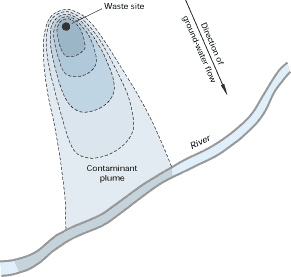M
Point and Nonpoint Sources of Contaminants
Contaminants may be present in water or in air as a result of natural processes or through mechanisms of displacement and dispersal related to human activities. Contaminants from point sources discharge either into ground water or surface water through an area that is small relative to the area or volume of the receiving water body. Examples of point sources include discharge from sewage-treatment plants, leakage from gasoline storage tanks, and seepage from landfills (Figure M-1).
Nonpoint sources of contaminants introduce contaminants to the environment across areas that are large compared to point sources, or nonpoint sources may consist of multiple, closely spaced point sources. A nonpoint source of contamination that can be present anywhere, and affect large areas, is deposition from the atmosphere, both by precipitation (wet deposition) or by dry fallout (dry deposition). Agricultural fields, in aggregate, represent large areas through which fertilizers and pesticides can be released to the environment.
The differentiation between point and nonpoint sources of contamination is arbitrary to some extent and may depend in part on the scale at which a problem is considered. For example, emissions from a single smokestack is a point source, but these emissions may be meaningless in a regional analysis of air pollution. However, a fairly even distribution of tens or hundreds of smokestacks might be considered as a nonpoint source. As another example, houses in suburban areas that do not have a combined sewer system have individual septic tanks. At the local scale, each septic tank may be considered as point source of contamination to shallow ground water. At the regional scale, however, the combined contamination of ground water from all the septic tanks in a suburban area may be considered a nonpoint source of contamination to a surface-water body.
Figure M-1: The transport of contamination from a point source by ground water can cause contamination of surface water, as well as extensive contamination of ground water.
